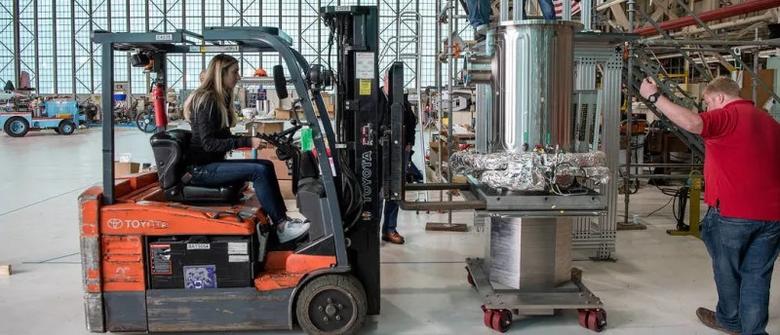
SMALL U.S. NUCLEAR FUEL

WNN - The US Department of Energy (DOE) has completed an environmental assessment clearing the way for the fabrication of high-assay low-enriched uranium (HALEU) fuel for advanced nuclear reactors at the Idaho National Laboratory (INL). Meanwhile, the US Department of Defense (DOD) has issued a Request for Information (RFI) for a small mobile reactor using HALEU fuel to provide electrical power in rapid response scenarios.
A final environmental assessment issued on 17 January determines that there will be no significant impact on the environment from using DOE-owned HALEU stored at INL to fabricate fuel at the laboratory's Materials and Fuels Complex (MFC), and possibly also at the Idaho Nuclear Technology and Engineering Center (INTEC), to support US companies in the development and deployment of new reactor technologies. The determination followed the publication in October 2018 of a draft environmental assessment, which remained open for public comment until 30 November.
The DOE's HALEU is from used fuel from the Experimental Breeder Reactor-II (EBR-II), which operated at the site from 1964 to 1994. Since 2000, DOE has employed an electrometallurgical treatment process at the MFC to refine and downblend the used high-enriched uranium fuel from the now-decommissioned reactor. About 10 tonnes of HALEU has been produced as a result of this process and is currently stored at INL.
Many advanced reactor designs currently under development will require HALEU fuel, enriched to between 5% and 20% in fissile uranium-235 (U235). The low-enriched uranium fuel used in today's nuclear power plants typically contains less than 5% U235. There are at present no commercial facilities in the US that are immediately capable of producing HALEU.
The decision means the federal government can fabricate HALEU fuel at INL from the lab's existing HALEU feedstock - mostly from the treatment of EBR-II fuel but also from some other small quantities of HALEU stored at the site - to support the near-term research, development and demonstration needs of private-sector developers and government agencies, including advanced reactor developers.
"This is a finite amount of HALEU with limited applications for specific advanced reactor designs but is one of several efforts undertaken by DOE to help ensure the availability of HALEU in support of the US nuclear power industry," the DOE said.
The DOE earlier this month announced plans to award a contract to a subsidiary of Centrus Energy Corp to demonstrate the production of HALEU using US-origin enrichment technology at the American Centrifuge Plant site in Piketon, Ohio.
DOD looking into mobile reactors
The US DOD on 18 January issued a Request for Information (RFI) to identify concepts for a "small mobile reactor" design that can address electrical power needs in rapid response scenarios.
"At a time when military operations are more energy-intensive than ever before, it is crucial that the [DOD] seek out game-changing technologies such as nuclear energy, which is a safe, reliable, and nearly unlimited resource," the RFI, issued by the Office of the Under Secretary of Defense for Research and Engineering, says.
Small mobile nuclear reactors can make domestic infrastructure resilient to an electrical grid attack and change the logistics of forward operating bases, both by making more energy available and by simplifying fuel logistics needed to support existing, mostly diesel-powered, generators. They would also enable a more rapid response during humanitarian assistance and disaster relief operations, the RFI notes.
"Small mobile nuclear reactors have the potential to be an across-the-board strategic game changer for the DOD by saving lives, saving money, and giving soldiers in the field a prime power source with increased flexibility and functionality," it says.
The mobile nuclear reactor is required to produce a threshold power of 1-10 MWe of generation, which it must be able to produce for at least three years without refuelling. It must weigh less than 40 tonnes and be sized for transportability by truck, ship, and C-17 aircraft. Designs must be "inherently safe", ensuring that a meltdown is "physically impossible" in various complete failure scenarios such as loss of power or cooling, and must use ambient air as their ultimate heat sink, as well as being capable of capable of passive cooling.
The reactor must be capable of being installed to the point of "adding heat" within 72 hrs and of completing a planned shutdown, cool down, disconnect and removal for transport in under seven days. They must be able to operate semi-autonomously and demonstrate minimisation of added proliferation risk. The RFI also specifies that the core design must use HALEU advance gas reactor tristructural isotropic fuel.
The RFI will also help inform a decision on whether to issue a Request for Solutions, with which it forms the first phase of what is anticipated will be a multi-phase prototype project. Up to three different reactor design efforts may be awarded under Phase I, which will include a full-scope reactor prototype engineering design study that is anticipated to take 9-12 months. One design would then be selected for Phase II, which would include a complete build and testing of the system prototype.
Interested parties have until 8 February to respond to the RFI.
-----
Earlier:

2019, January, 14, 11:05:00
U.S. NUCLEAR FOR AFRICAISSUES - Yet the United States still has an opportunity to help interested African nations overcome the obstacles to realizing their energy ambitions. Whereas Russia and China have large government investments in a few advanced nuclear technologies, the United States has a robust and thriving private sector for advanced nuclear development, drawing on both decades of public research and development and a high-tech investment ecosystem. From large national laboratories to small venture-backed start-ups, the United States has over 50 firms working on a diverse portfolio of advanced nuclear designs, many targeting smaller or niche markets.
|

2018, December, 21, 13:45:00
U.S. THERMONUCLEAR PARTICIPATIONWNN - The USA should continue its participation in the International Thermonuclear Experimental Reactor (ITER) project and develop a national research programme towards building a compact pilot plant, according to the National Academies of Sciences, Engineering, and Medicine (NASEM).
|

2018, November, 14, 11:45:00
U.S. NUCLEAR CAPEX DOWN 40.8%WNN - in 2017 the average total generating cost - which includes capital, fuel and operating costs - for nuclear energy was USD33.50 per megawatt-hour (MWh).
|

2018, October, 31, 13:05:00
SMALL NUCLEAR IS BETTERWNN - Where a modern new nuclear project will typically have a rated capacity of between 1000 and 1600 megawatts electric, an SMR will have a capacity of around 300 MWe or less. Modular means that the major components of the SMR will be built in a factory and assembled on-site. By being small and modular, SMRs have many advantages when compared to traditional large reactors.
|

2018, October, 4, 14:20:00
U.S. URANIUM LOWSU.S. EIA - During 2017, owners and operators of U.S. nuclear power plants purchased 40 million pounds of uranium from foreign suppliers. Canada, Australia, Russia, Kazakhstan, and Uzbekistan represented the top five countries of origin and together accounted for 84% of total U.S. uranium purchases in 2017.
|

2018, September, 17, 14:50:00
U.S. & BRITAIN NUCLEAR RESEARCHWNN - The UK's National Nuclear Laboratory (NNL) and the US Department of Energy's Oak Ridge National Laboratory (ORNL) have agreed to cooperate on nuclear energy research. The announcement came as the UK and USA signed a nuclear R&D action plan.
|

2018, July, 23, 13:10:00
U.S. URANIUM PRODUCTION: 5%U.S. DC - U.S. uranium production had been 49 percent of U.S. requirements in 1987. Today, U.S. uranium production has dropped to only five percent of U.S. requirements. |



